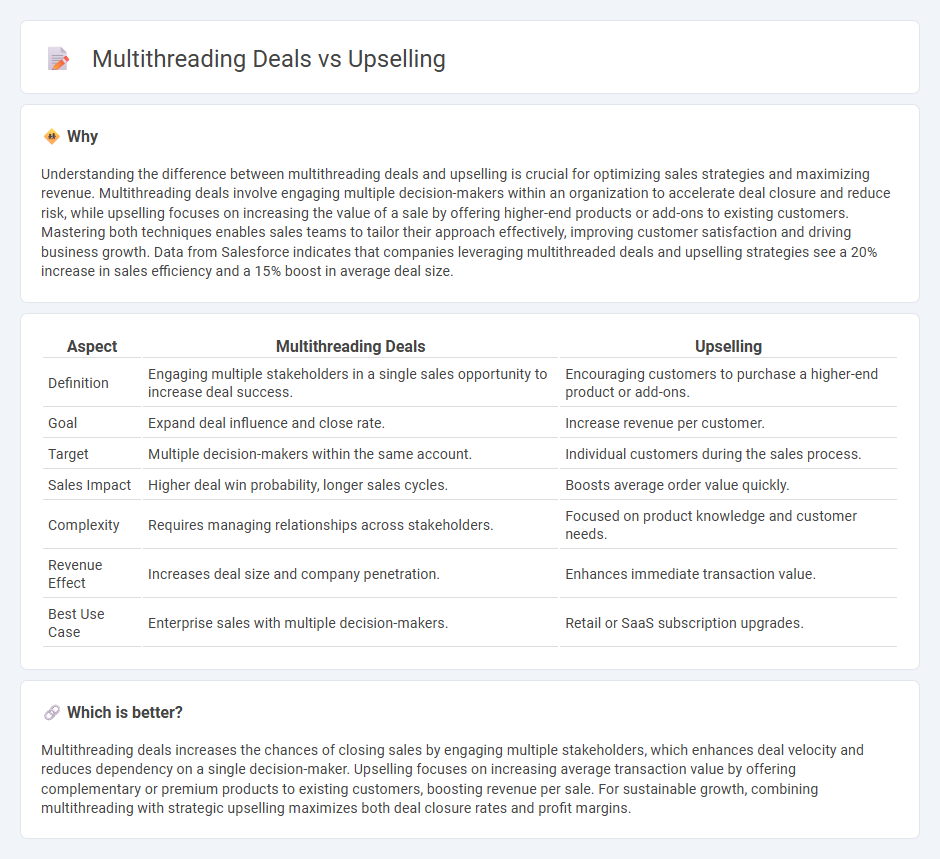
Sales strategies involving multithreading deals enhance client engagement by involving multiple stakeholders to secure agreements efficiently, while upselling focuses on increasing transaction value by promoting premium product options to existing customers. Effective multithreading reduces sales cycle duration and risk, whereas upselling boosts revenue per customer and strengthens product adoption. Explore detailed tactics to optimize these approaches and drive revenue growth in your sales process.
Why it is important
Understanding the difference between multithreading deals and upselling is crucial for optimizing sales strategies and maximizing revenue. Multithreading deals involve engaging multiple decision-makers within an organization to accelerate deal closure and reduce risk, while upselling focuses on increasing the value of a sale by offering higher-end products or add-ons to existing customers. Mastering both techniques enables sales teams to tailor their approach effectively, improving customer satisfaction and driving business growth. Data from Salesforce indicates that companies leveraging multithreaded deals and upselling strategies see a 20% increase in sales efficiency and a 15% boost in average deal size.
Comparison Table
| Aspect | Multithreading Deals | Upselling |
|---|---|---|
| Definition | Engaging multiple stakeholders in a single sales opportunity to increase deal success. | Encouraging customers to purchase a higher-end product or add-ons. |
| Goal | Expand deal influence and close rate. | Increase revenue per customer. |
| Target | Multiple decision-makers within the same account. | Individual customers during the sales process. |
| Sales Impact | Higher deal win probability, longer sales cycles. | Boosts average order value quickly. |
| Complexity | Requires managing relationships across stakeholders. | Focused on product knowledge and customer needs. |
| Revenue Effect | Increases deal size and company penetration. | Enhances immediate transaction value. |
| Best Use Case | Enterprise sales with multiple decision-makers. | Retail or SaaS subscription upgrades. |
Which is better?
Multithreading deals increases the chances of closing sales by engaging multiple stakeholders, which enhances deal velocity and reduces dependency on a single decision-maker. Upselling focuses on increasing average transaction value by offering complementary or premium products to existing customers, boosting revenue per sale. For sustainable growth, combining multithreading with strategic upselling maximizes both deal closure rates and profit margins.
Connection
Multithreading in sales involves engaging multiple stakeholders across different departments simultaneously, increasing the likelihood of closing deals by addressing diverse needs. This approach enhances upselling opportunities by identifying various pain points and proposing complementary products tailored to each stakeholder. Efficient multithreading accelerates decision-making and amplifies revenue growth through strategic relationship management.
Key Terms
Cross-Selling
Cross-selling enhances revenue by promoting complementary products alongside the primary purchase, increasing average order value and customer satisfaction. Unlike multithreading deals, which target simultaneous engagement with multiple offers, cross-selling focuses on relevant add-ons tailored to customer needs. Explore deeper strategies to optimize cross-selling for boosted profitability and customer retention.
Decision Makers
Upselling targets decision makers by encouraging higher-value purchases of related or premium products within the same transaction, maximizing revenue per customer. Multithreading deals engage multiple stakeholders simultaneously to streamline the decision-making process and increase the likelihood of closing complex sales. Explore strategic approaches to effectively leverage upselling and multithreading to boost deal success rates.
Account Expansion
Upselling strategies emphasize increasing revenue by encouraging customers to purchase higher-value products or services within an existing account, enhancing account expansion through targeted offerings tailored to client needs. Multithreading deals involve engaging multiple stakeholders across different departments within the same organization to secure broader buy-in and drive complex sales growth for expanded account penetration. Explore deeper insights into how combining upselling and multithreading can maximize account expansion and drive sustainable revenue growth.
Source and External Links
Upselling - Wikipedia - Upselling is a sales technique where a seller encourages a customer to purchase more expensive items, upgrades, or add-ons to generate more revenue, distinct from cross-selling which suggests additional products.
How To Upsell: 15 Upselling Tips & Examples To Boost Revenue - Upselling suggests a better or more expensive version of a product or service to a customer already interested in buying, aiming to increase the sale's value while meeting customer needs.
What Is Upselling? Upselling Definition and Examples - Shopify - Upselling is a legitimate sales strategy to encourage customers to buy higher-end items or add-ons, enhancing customer experience and increasing revenue.
 dowidth.com
dowidth.com